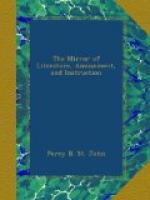VERITAS.
* * * * *
BRIGHTON IN 1743.
[Illustration: Brighton in 1743.]
(Whoever has enjoyed the natural beauties or artificial luxuries of BRIGHTON—the Daphne of our metropolis—will feel some curiosity respecting its origin and progress from an obscure fishing-town to such a focus of wealth and fashion as at this moment it presents. The celebrity of Brighton, we may observe, extends throughout the empire, and is almost as well known to the plodding and stay-at-home townsman of the north as to the luxurious idler ever and anon in quest of new pleasures. As the occasional abode of the Royal Family, its name has figured in the Court records of the last half century. Of late years, however, Brighton has assumed an extent and importance which may be referred to a spirit of speculative enterprise unparalleled in the fortunes of any other town in the United Kingdom. Not only has a palace, but squares of palatial mansions, terraces, crescents, and streets, nay, very towns of splendid houses, have sprung up with fairy-like rapidity; and Brighton has thus become, not merely a fashionable resort for the season, but a place of permanent residence for a very large proportion of wealthy individuals. Our present purpose is, however, to illustrate the past obscurity and not the present high palmy state of Brighton. Our own recollections would carry us back nearly a score of years, when the Pavilion or Marine Palace was a plain, neat, villa-like building, with verandas to command a prospect of the sea; and when the Steines scarcely merited the designation of enclosures: when a roomy yellow-washed mansion occupied the upper end of the old Steine, and was pointed to as once the house of Dr. Russell, to whom Brighton owes much of its early fame; its site being now occupied by a superb hotel: when Phoebe Hassell and Martha Gunn were the lionesses of the place—the one by land and the other by sea: and when not a carriage entered Brighton without the electioneering salute of half a score of blue gownswomen with cards of their crazy machines to give you a tenancy-at-will of the ocean. But, our quoted particulars of Brighton invest it with a much earlier interest than our brief memory can supply. They are historical as well as topographical, from the primitive records of the place, and are accompanied by a view of the town from the sea, as it appeared in the year 1743, or about 90 years since. For this and the interesting details which accompany it we are indebted to a History of Brighthelmston published by Dr. Anthony Rhelan towards the close of the last century, and lately edited and reprinted by Mr. Mitchell of Brighton, with the benevolent intention of aiding the funds of the Sussex County Infirmary, by the profits arising from the sale of the work. It requires an almost microscopic eye to distinguish the buildings in the Cut. The Royal standard on the fort, is, by an error of the artist, disproportionally large.) The town of Brighthelmston,[1] in the county of Sussex, is situated on the banks of the sea, at the bottom of a bay of the same name, formed to the east by Beachy-Head, and by Worthing point to the West.




